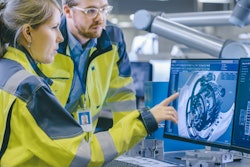
Catalytic announced findings from its 2020 report on closing the digital maturity gap and scaling process automation enterprise-wide to gain competitive differentiation and ensure exceptional customer experiences.
Catalytic conducted a cross-industry survey of 600 enterprise C-suite leaders, department directors and managers, including automation leaders. The research report, “The Real State of Automation Progress,” aims to uncover the status of digital transformation and the scaling of automation across enterprises.
This study examined where businesses see themselves compared to competitors in terms of adopting automation tools, how equipped companies and specific departments are to take process automation to the next level, who’s involved in decisions about automation and what factors hold companies back from reaching digital maturity.
“Our findings confirm that despite all departments seeing the potential of automation, most companies are not achieving their goals and need to rethink the roles, responsibilities and technologies leveraged to ensure greater success,” says Sean Chou, CEO and co-founder of Catalytic. “Specifically, our report underscores why organizations need to look beyond RPA tools to truly scale their automation efforts and adopt a federated model so that multiple lines of business can actively participate while maintaining a strong central governance at the core.”
Key findings from the report include:
The workforce is optimistic about automation’s potential to make jobs easier
The report found that as employees get more familiar with process automation, they become more optimistic about its implementation and benefits. For example, 93% of respondents believe automation will make their jobs easier, especially those working within IT, procurement, operations, finance and HR. Findings show that 42% of those who are “unfamiliar” with automation still feel optimistic about its benefits. This percentage increases to 89% of those who are “somewhat familiar” with the concept. Based on this, Catalytic’s study shows that educating employees across departments will heighten their comfort level with automation technology.
Enterprise over-reliance on centralized models for automation hinders from reaching digital maturity
Catalytic’s report found that automation initiatives are heavily centralized with a dedicated team responsible for its implementation and usage. While only 22% of respondents operate in a distributed model, organizations who use this approach to automation view the ROI as much higher than expected. Responses pointed to IT bottlenecks as the biggest enterprise challenge to reaching digital maturity, indicating a need to distribute automation efforts across the organization.
Companies must reimagine roles to empower business users and amplify IT teams
Catalytic’s findings prove that digital transformation shouldn’t have gatekeepers – meaning organizations need to reshape how to effectively roll out automation across the business. The IT department represents only 3.7% of the average company and is most effective at providing oversight and governance for projects. Further, when business users deploy their own projects and shift their roles for the future of work, organizations have 27 times more resources to scale while eliminating bottlenecks and requirement gaps in the process.
With 61% of automation leaders prioritizing upskilling their staff beyond IT, it’s clear that enterprises are beginning to see the benefits of reimagining how and who plays a part in digital innovations. To assist with upskilling efforts and get employees more involved in decision making, organizations should consider introducing a low-code platform that allows technically-minded business users to build automated workflows for their teams without the need for traditional computer programming skills.
Managers don’t feel as optimistic as their C-suite leaders
C-suite and managers were asked to characterize the maturity of their automation efforts as “Novice,” “Intermediate,” “Advanced” or “Pro.” The C-suite (21%) is more likely than managers to characterize their organization’s automation efforts as “Pro,” indicating their view from the top might be clouded and aspirational compared to managers. While 79% of managers cited their automation efforts as “Advanced” or “Intermediate,” only 9% currently rate their strategies as “Pro.” This shows further communication and collaboration between all departments, and the involvement of managers in decision-making and execution is necessary to change the narrative of automation to be more optimistic. This includes using automation to create more opportunities for people on the front lines of an organization to do more meaningful work. Automation initiatives that remain centralized will continue to contribute to the lack of department-specific confidence in automation skills.


















